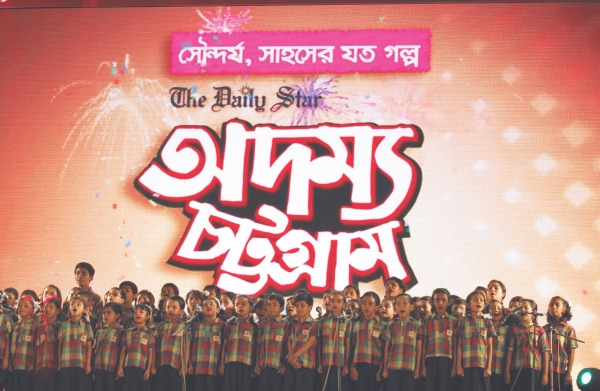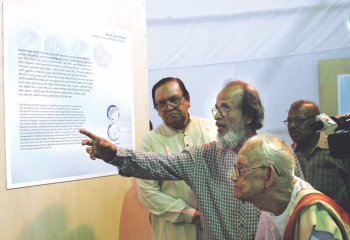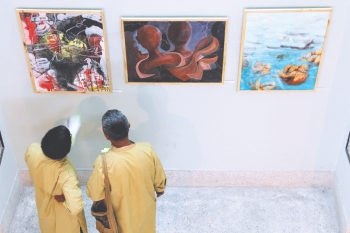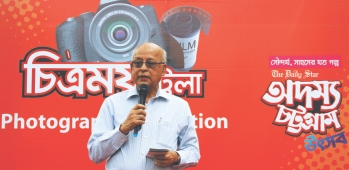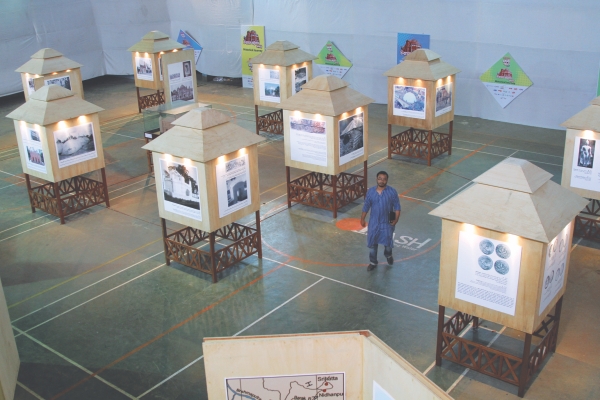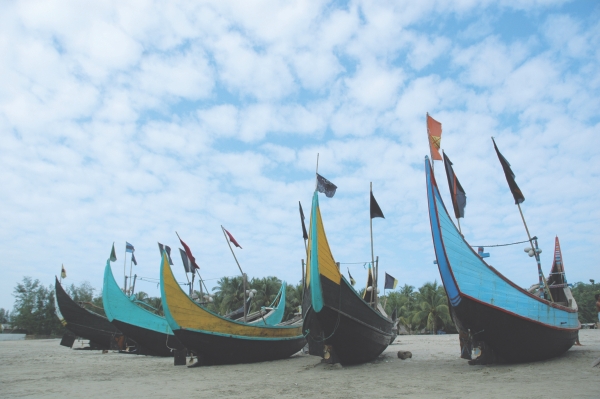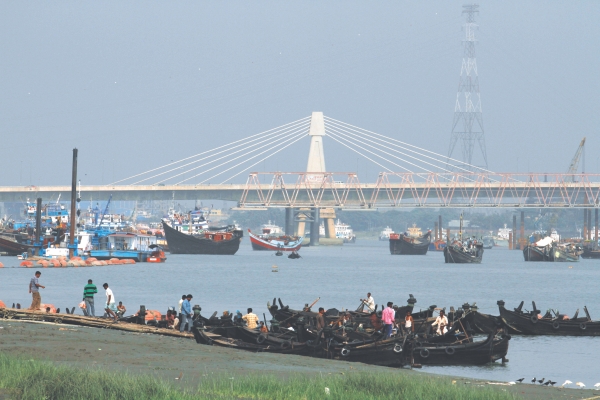| Home - Back Issues - The Team - Contact Us |
 |
| Volume 11 |Issue 14| April 06, 2012 | |
|
|
Cover Story
The Indomitable Spirit of Chittagong Naimul Karim A Chinese poem, from the 7th century AD, describes Chittagong as a 'sleeping beauty emerging from mists and water'. Although written centuries ago, the description still holds true for the city that has been Bangladesh's economic, touristic and cultural centre for a long time now. From breeding historic revolutionaries such as Surya Sen to propagating a multi-cultured way of living, the city boasts of celebrated tales and traditions. More recently, the port city of Bangladesh, considered to be the economic capital of the country due to its booming trade figures, was declared as the 10th fastest growing city in the world. Despite containing a series of success stories, Chittagong's triumph has often been overlooked due to the national administration's capital-centric approach. From businessmen aiming to establish a foothold to artists trying to make a name for themselves, eminent personalities from Chittagong claim that it's almost impossible to climb up the ladder, unless and until one moves to Dhaka. With an aim to change the current notion and promote the indomitable spirit of Chittagong, The Daily Star began a 17-day festival entitled 'Odommo Chattagram' on the 25th of March. From showcasing the 1400-year long history of Chittagong to providing a platform for artists, photographers and businessmen, the three-week long programme aspires to explore the various features of the city.
An expressive photo exhibition, describing the various kinds of lifestyle and the different aspects of the city set the tone for the festival, as hundreds of people flocked to the Theatre Institute to have a glance at the photos displayed at the 'Chitromoy Chattala'. “It's hard to believe that some of these pictures have been taken in Chittagong. It's also kind of an eye-opener since many of us don't even know that such beautiful places exist in Bangladesh,” exclaims Sadi Chowdhury, a third year student from Chittagong. Emphasising on the growing culture of photography in Chittagong, resident editor of Prothom Alo, Abul Momen, says, “Although several Chittagonian photographers have won international accolades, they are still not known in Dhaka.” From pictures describing the life of the workers at the ship-breaking yards to photos of fishermen going about their daily dose of work, the images narrated stories of dwellers from almost every corner of the city. Amongst all however, a photo, clicked by Adrian Poran, of a Buddhist monk meditating under a hanging umbrella won the first prize at the event. The photo depicts a unique method of meditation followed by monks in Chittagong.
Pictures weren't the only 'still' frames used to represent the port city. The Rashid Chowdhury Auditorium of Fine Arts Institute, Chittagong University, hosted a painting exhibition which saw several artists portray their city in different ways. A painting by Shaela Sharmin,a teacher at the institute, for instance, depicted the importance of maintaining an ecological balance in the fast-developing city. Another work of art focused on preserving the dying rivers of the country. “These paintings are testimony of the kind the talent that is in store in Chittagong. There is a lot of potential which hasn't been tapped as yet. These artists need recognition,” explains Shaela Sharmin Describing the struggle of artists in Chittagong, Abul Mansur, professor, of art history says, “There are several museums and art exhibitions in Dhaka, because of which artists get recognition; here however, that is not the case. If an artist in Chittagong can manage to sell even one painting it's considered to be an achievement. While there is a lot of talent, one needs more support. It is important that one sees the meaning of true art.” Chittagong boasts of a rich colonial history which saw various dynasties rule the port city. From Portuguese rulers to the Mughal Empire, the city was of the highest importance due to its geographical location. However, due to the failing site-conservation techniques, the city has lost a number of historic ruins. Depicting the history of the city through important monuments, the Chirayato Chattagram Prodarshani (Eternal Chittagong Exhibition), which took place at the gymnasium, M.A. Aziz Stadium, provided an insight into the different stages of Chittagonian history. “These old sites represent the city's past and its culture. If they fade away then so will our history and that's going to create a lot of trouble for the future generation,” explains Shamsul Hossain, curator of the exhibition. Explaining the dire state of the archaeological ruins, he adds, “There is absolutely no help from the government to protect our sites, none at all. If these ruins disappear then how can the city represent itself? How can people grow up without knowing their own history? Their own culture?” Stating an example of the administration's careless attitude towards these sites, Islam says, “Andarkilla, which is believed to be a pre-Mughal site has been badly affected due to the unplanned growth of the city. It's a site which should be conserved so that some heritage of the city still remains alive.” He further states that there are several other ruins that need protection and hopes that events like these can make people realise their importance and bring a positive change. Describing the ominous situation of the relics, Professor Abu Sayeed Ahmed, University of Asia Pacific claims that while the fast-paced growth of the city is a good sign, it has put a lot of pressure on archaeological sites, leading to their destruction. “ There are as many important sites in Chittagong as there are in Dhaka, however, the conservation practices over here are non-existent,” says Ahmed, who is currently working on a project that aims to conserve a 250-year-old mosque in the city. He further states that archaeological history in Bangladesh revolves around Chittagong. “The city is very important in terms of culture. It's almost impossible to talk about architecture without mentioning the railway buildings here,” exclaims Ahmed. From displaying the thorough monetary system followed by the Kingdom of Harikela, dating back to the 7th century AD to narrating tales from the Chittagong uprising, the exhibition, which went on for five days, provided an invaluable description of the port city. “It's only through events like Odommo Chattagram that I can manage to display such work. Historians from Chittagong need the government's support to do more research and provide more platforms to publicise their findings. It can only strengthen our culture,” says Islam.
Representing the city's theatre artists were two events that took place that took place in the Theatre Institute and the Shilpakala Academy till Thursday. A series of plays directed by local artists were staged at both the platforms and received an over-whelming audience. “Chittagonian plays have always been unique because of the presence of a multi-cultured society. They have always managed to represent different cultures and deserves a separate mention in the field of arts in Bangladesh,” says Shishir Dutta, noted theatre artiste, who inaugurated the theatre fest at the Shilpakala Academy. He further hopes that festivals like Odommo Chattagram can take theatre beyond city life and represent the kind of life lead by the villagers in Chittagong. “Our villagers suffer from various problems; poverty, lack of electricity, drought etc. Theatre can be a good medium to depict these problems so that people realise the kind of hardships they face,” says Dutta.
Apart from breeding a rich theatre-based culture, the city has also produced a number of award winning films which have received international acclaim. The Last Rites, directed by Yasmin Kabir, for instance went on to win the Travelling Film South Asian Award in 2009. The silent film depicting the ship-breaking yards of Chittagong, describes how thousands of people risk their lives by working in unsuitable conditions just to save themselves from hunger. Thus in order to promote the Chittagonian film culture, Odommo Chattagram included a film fair, which began on Wednesday at the Fulki auditorium at DC Hill. The festival was inaugurated by renowned filmmaker, Mustari Sofi and will conclude on Saturday.
The latter half of the festival saw various entertaining events which managed to draw huge crowds. One of them was the local food-fest, organised with the help of members from the Chittagong Women's Chamber. Known for its scrumptious delicacies, it wasn't a surprise when thousands of people flocked into the MA Aziz Gymnasium to have a go at the sweet 'Bakorkhanis' (not at all similar to the ones found in Dhaka) and the spicy Mezbaner Goshto. It was a crowded affair right from the beginning till the very end. The festival also witnessed five famous cooks from the city receiving medallions for their services. As of today, the festival is scheduled to witness a traditional Chittagonian boat race called the 'Sampan Baitch', a race that will witness 30 boats battling it against each other till the finish line. The competition will begin at 3pm at the Bridge Ghat. Odommo Chattagram also plans to provide a platform for various Chittagonian businessmen to come together and further enhance their trade in the port city by organising a three-day Economic Conference and Brand Expo beginning tomorrow at Hotel Agrabad and the MA Aziz Stadium respectively. Saturday will also prove to be a toddler's delight with a children's festival being organised at the Fulki School from 10 am onwards.
The Daily Star's initiative to revive the spirit of Chittagong is a move that aims to benefit the entire nation along with the port city. The huge participation in these events prove that residents of Chittagong have as much potential, in various fields, as that of the capital. For the nation to progress, the capital-centric approach needs to change. Historians, artists, business persons and people from every other sector in Chittagong have been craving for recognition for a while now and Odombo Chattagram has taken a step towards providing them what they deserve. One hopes that this becomes a regular affair and that the spirit of the port city never dies. As revolutionary Binod Bihari from Chittagong puts it, “Chittagong has always been indomitable. It's been a pioneer and will continue being one.”
|
||||||||||||||
Copyright
(R) thedailystar.net 2012 |

